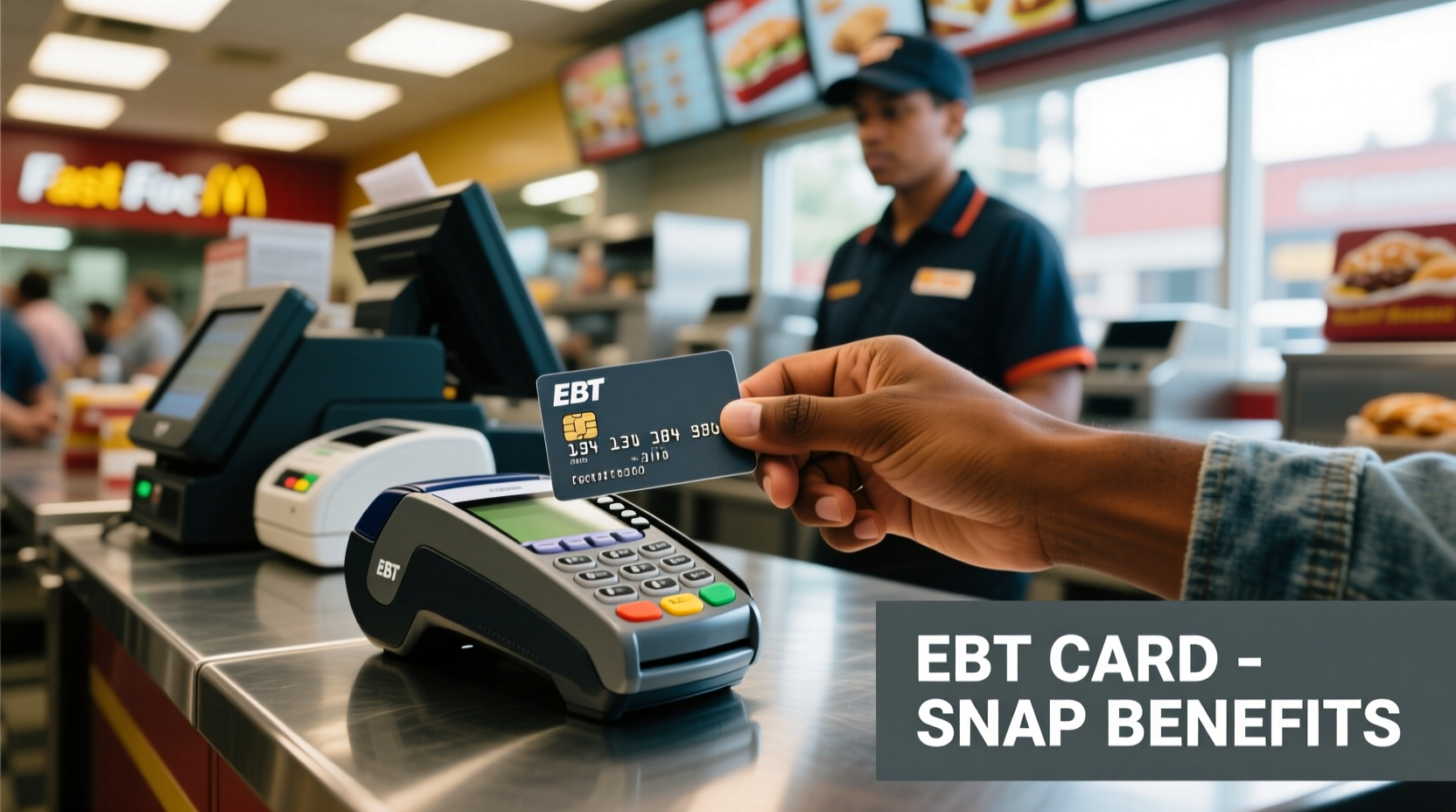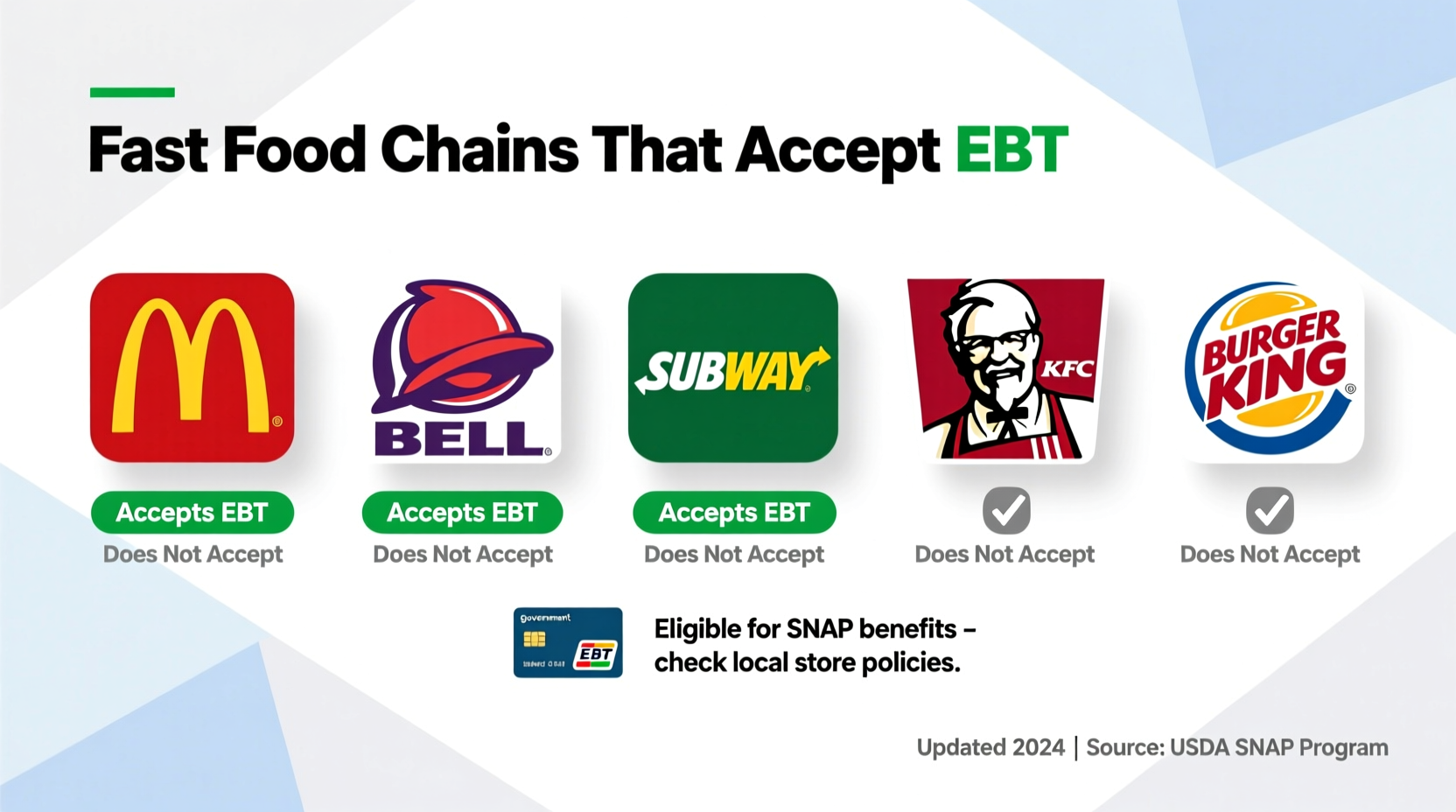Only select fast food restaurants in specific states accept EBT through the Restaurant Meals Program (RMP). As of 2024, McDonald's, Burger King, Subway, and Taco Bell participate in RMP in Arizona, California, Michigan, and Rhode Island. Eligibility is limited to seniors (60+), people with disabilities, and homeless individuals. Most fast food chains do NOT accept EBT nationwide.
Looking for fast food options that accept EBT? You're not alone. Millions of SNAP beneficiaries search for convenient meal solutions, but the reality of using EBT at fast food restaurants is more limited than many realize. This guide provides the most current, verified information about which fast food chains accept EBT payments, where they operate this service, and who qualifies.
Understanding where you can use your EBT benefits for prepared meals can significantly impact your food access, especially if you lack cooking facilities or face mobility challenges. Let's explore the facts behind EBT acceptance at fast food establishments.
Understanding the Restaurant Meals Program (RMP)
The Restaurant Meals Program isn't a universal option—it's a state-administered program that allows certain SNAP recipients to use benefits at participating restaurants. This crucial distinction explains why most fast food locations don't accept EBT cards.
Unlike grocery purchases with SNAP benefits, the RMP serves specific vulnerable populations who face challenges preparing meals at home. The program exists to provide food access solutions for those who might otherwise go hungry.
Current Fast Food Chains Accepting EBT
As of 2024, the following fast food chains participate in the Restaurant Meals Program in select states:
- McDonald's (in AZ, CA, MI, RI)
- Burger King (in AZ, CA, MI)
- Subway (in AZ, CA)
- Taco Bell (in CA)
It's important to note that participation varies by location even within participating states. Not every franchise of these chains accepts EBT, so verification is essential before visiting.
| State | Participating Chains | Special Requirements |
|---|---|---|
| Arizona | McDonald's, Burger King, Subway | Must be elderly, disabled, or homeless |
| California | McDonald's, Burger King, Subway, Taco Bell | Must be elderly, disabled, or homeless |
| Michigan | McDonald's, Burger King | Must be elderly or disabled |
| Rhode Island | McDonald's | Must be elderly or disabled |
Who Qualifies for Restaurant EBT Purchases?
Not all SNAP recipients can use EBT at restaurants. The Restaurant Meals Program specifically serves three vulnerable populations:
- Individuals aged 60 or older
- People with disabilities (as defined by SNAP)
- Homeless individuals
If you don't fall into one of these categories, you cannot use your EBT card to purchase prepared meals at restaurants, regardless of location. This restriction exists because SNAP benefits are primarily designed for purchasing groceries to prepare at home.
How the Restaurant Meals Program Has Evolved
The RMP has undergone significant changes since its inception. Understanding this timeline helps explain current limitations:
- 1977: Restaurant Meals Program first authorized as a federal option
- 1980s-1990s: Limited state participation, primarily serving elderly populations
- 2000s: Expanded to include people with disabilities in some states
- 2008: Homeless population added to eligible groups in select states
- 2010s: California and Arizona significantly expanded RMP participation
- 2020-2022: Temporary expansions during pandemic (mostly reverted)
- 2024: Four states maintain active RMP with major fast food chains
According to the USDA Food and Nutrition Service, the program remains optional for states, which explains the significant geographic disparities in availability (fns.usda.gov/snap/restaurant-meals-program).
How to Verify EBT-Accepting Locations Near You
Don't assume a restaurant accepts EBT just because it's part of a participating chain. Follow these verification steps:
- Check your state's SNAP website for official RMP information
- Call the specific restaurant location directly
- Look for RMP signage at participating locations
- Ask your local SNAP office for updated participating restaurant lists
- Use the USDA's SNAP Retailer Locator tool (filter for RMP)
Many beneficiaries report that calling ahead saves time and avoids embarrassment at the register. Restaurant staff may not always be fully trained on EBT acceptance procedures, so patience is often necessary.

What to Expect When Using EBT at Fast Food
If you qualify and find a participating location, here's what the process typically involves:
- Inform the cashier you'll be using EBT before ordering
- Only certain menu items may be eligible (typically standard meals)
- You cannot use EBT for alcohol, tobacco, or non-food items
- Some locations have minimum purchase requirements
- Cash back is not available with EBT restaurant transactions
- Tip cannot be paid with EBT funds
Many participants report that the process works smoothly once the cashier understands the procedure. Having your EBT card ready and knowing your balance beforehand can streamline the transaction.
Common Misconceptions About EBT and Fast Food
Several myths persist about EBT usage at restaurants. Let's clarify:
- Myth: All fast food restaurants accept EBT nationwide
Fact: Only select locations in four states participate in RMP - Myth: Anyone with an EBT card can buy fast food
Fact: Only seniors, disabled individuals, and homeless people qualify - Myth: EBT works like a regular debit card at restaurants
Fact: Special processing and staff training are required - Myth: The pandemic permanently expanded restaurant EBT acceptance
Fact: Most temporary expansions ended in 2022-2023
According to a 2023 analysis by the Center on Budget and Policy Priorities, misinformation about restaurant EBT acceptance often leads to unnecessary embarrassment for SNAP recipients when attempting to use benefits (cbpp.org/research/food-assistance/snap-restaurant-meals-program).
Alternative Options When Restaurant Meals Aren't Available
If you don't qualify for RMP or live in a state without the program, consider these alternatives:
- Grocery stores with prepared food sections (many accept EBT for these)
- Food banks and meal programs specifically for vulnerable populations
- Community centers offering free or low-cost meals
- SNAP-eligible convenience stores with hot food options
- Local churches and non-profits providing meal services
Many communities have resources that aren't widely advertised. Contacting your local Area Agency on Aging can connect you with meal programs for seniors, while disability service organizations often maintain lists of accessible food options.
Staying Updated on EBT Restaurant Changes
Program details can change, so stay informed through these reliable channels:
- Your state's official SNAP website
- USDA Food and Nutrition Service updates
- Local SNAP office notifications
- Non-profit organizations serving low-income populations
Some states have waiting lists for RMP participation or periodically add new restaurant partners. Being on email lists from your state's SNAP program can alert you to new opportunities.











 浙公网安备
33010002000092号
浙公网安备
33010002000092号 浙B2-20120091-4
浙B2-20120091-4